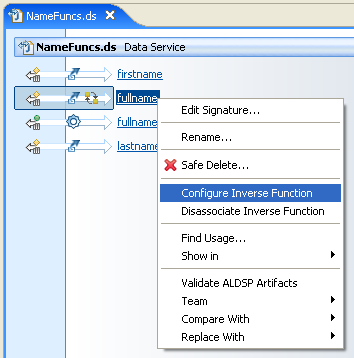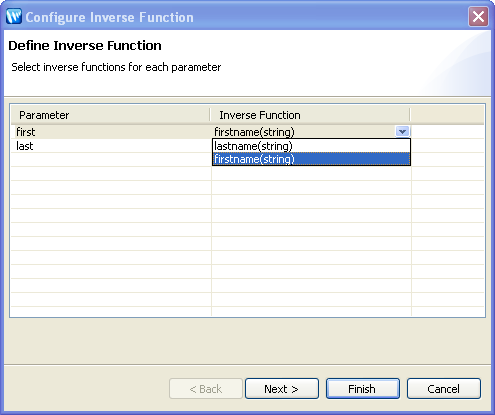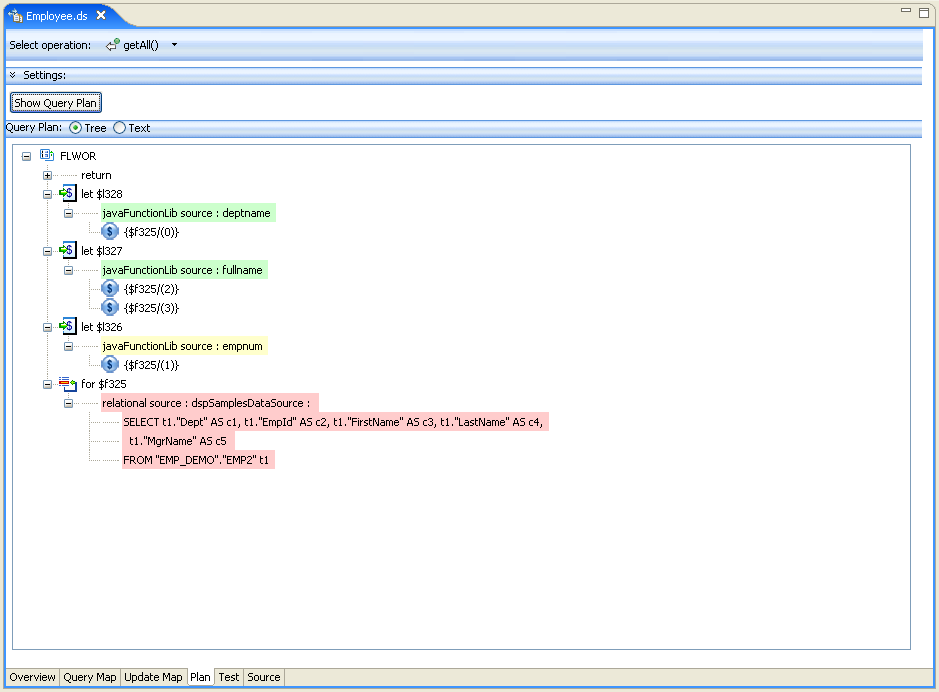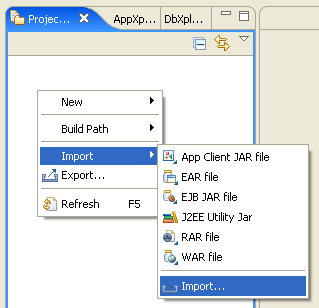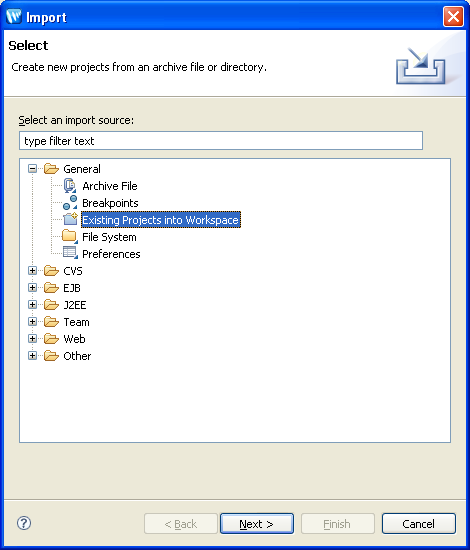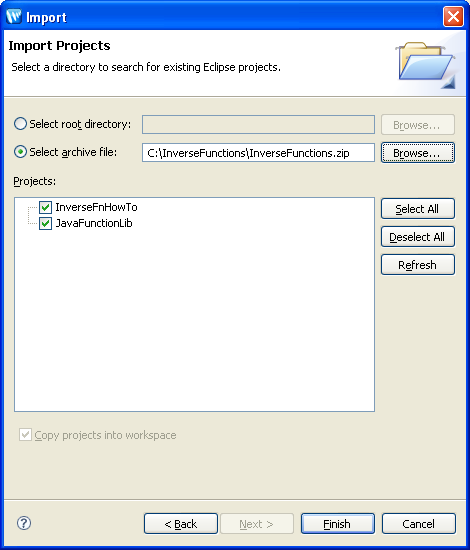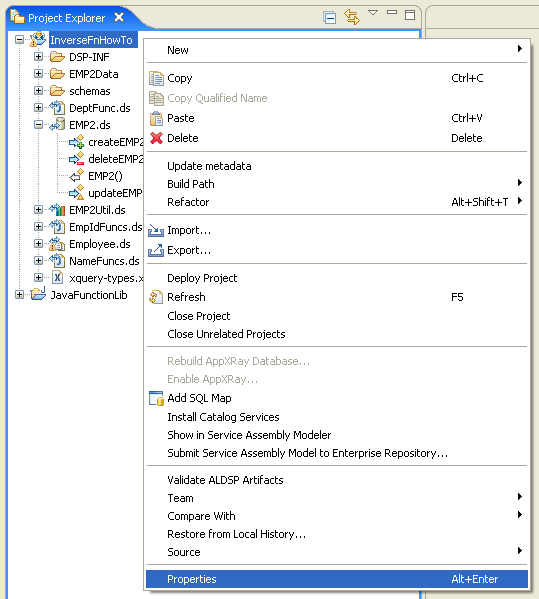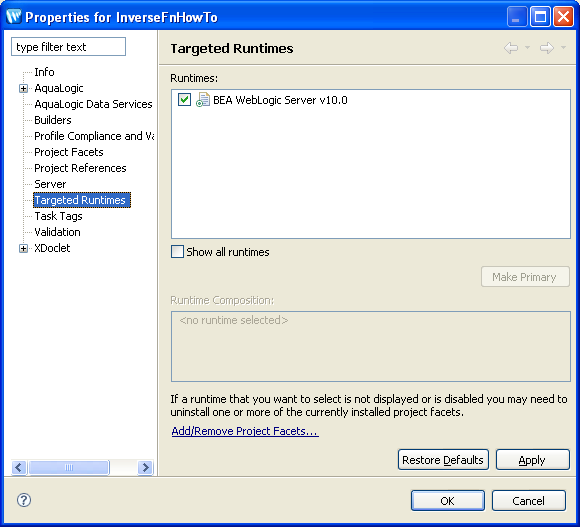|
This page collects the following related topics on a single HTML page:
This arrangement is designed to facilitate printing of the entire topic. Some duplication of references, link headers, and "Related Topics" information may be observed. |
edocs Home > BEA AquaLogic Data Services Platform 3.0/3.2/3.01 Documentation
| Authors |
Mike Carey, Sachin Thatte, John Jerney |
| Versions |
ALDSP 3.0, 3.2, 3.01 |
Using Inverse Functions to Improve Query Performance
| Prefer all related topics on a single page? Click here. |
This topic introduces the concept of inverse functions, and explains how you can use reverse transformations to improve query performance.
Topic Map
Overview
When designing and implementing data services, one of the principal goals is to provide a set of abstractions that enable client applications to see and manipulate integrated enterprise data in a clean, unified, meaningful, canonical form. Doing so invariably requires transforming data, which can include restructuring and unifying the schemas and the instance-level data formats of the disparate data sources.
In such cases, names may be reformatted, addresses normalized, and differences in units reconciled, among other operations, to provide application developers (the consumers of data services) with a natural and easily manipulable view of the underlying data. Such transformations, while highly useful to the end consumers of the data, can lead to performance challenges when retrieving underlying data.
When the resulting data is queried, it is crucial for performance that much of the query processing (especially for selections and joins) be pushable to the underlying sources, particularly to relational data sources. This requires updates to the transformed view of the data to be translatable back into appropriate source updates. Unfortunately, if data transformations are written in a general-purpose programming language, such as Java, both of these requirements can be difficult. This is because, unlike user-written XQuery functions, such general-purpose functions are opaque to the ALDSP query and update processors.
The Inverse Function Solution
To solve this issue, ALDSP enables data service developers to register inverse functions with the system, enabling you to define and use general user-defined data transformations without sacrificing query pushdown and updatability. Using this information, ALDSP is able to perform a reverse transformation of the data when analyzing query predicates or attempting to decompose updates into underlying data source updates.
This means that you can use inverse functions to retain the benefits of high-performance data processing for your logical data without giving up application-oriented convenience data functions. In addition, inverse functions enable automated updates without the need to create Java update overrides.
|
Using inverse functions effectively and correctly requires careful design. In particular, you must ensure that the functions are true inverses of one another, otherwise ALDSP may perform undesired operations on your data. While inverse functions are an intuitive and useful idea, be aware that the details require careful attention. |
Understanding Invertible Functions
The thing to keep in mind when creating inverse functions is that the functions you create need to be truly invertible.
For example, in the following case date is converted to a string value:
public static String dateToString(Calendar cal) { SimpleDateFormat formatter; formatter = new SimpleDateFormat("MM/dd/yyyy hh:mm:ss a"); return formatter.format(cal.getTime()) ; }
However, notice that the millisecond value is not in the return string value. You get data back but you have lost an element of precision. By default, all values projected are used for optimistic lock checking, so a loss of precision can lead to a mismatch with the database's original value and thus an update failure.
Instead the above code should have retained millisecond values in its return string value, thus ensuring that the data you return is exactly the same as the original value.
How Inverse Functions Can Improve Performance
Here are some additional scenarios where inverse functions can improve performance, especially when large amounts of data are involved:
- Type mismatches. A UK employees database stores date of hire as an integer number; the U.S. employees database stores hire dates in a datetime format. You can convert the integer values to datetime, but then searching on hire date would require fetching every record in the database and sorting at the middleware layer. In this situation, you could use inverse functions to take advantage of each database's hire date index.
- Data Normalization. In order to avoid confusion of UK and U.S. employees, a data service function prepends a country code to the employee IDs of both groups. Again, sorting based on these values will be time consuming since the processing cannot be achieved on the backend without modifying the underlying data. Inverse functions can be used to remove the prepended country code when pushing the operation down to the underlying database.
- Data Transformation. A logical data service has a fullname operation that concatenates firstname and lastname elements. Any attempt to sort by fullname would be penalized by the required retrieval of information on all customers, followed by local processing of the returned results.
- Data Conversion. There are many cases where values need to be converted to their inverse based on established formulas. For example there could be a requirement that the application retrieve customers by date as an xs:dataTime rather than as a numeric. In this way users could supply date information in a variety of formats. Consider an example where the data architect creates the following XQuery function:
declare function tns:getEmpWithFixedHireDate() as element(ns0:usemp)*{ for $e in ns1:USEMPLOYEES() return <emp> <eid>{fn:data($e1/ID)}</eid> <name>{mkName($e1/LNAME, $e1/FNAME)}</name> <hiredate>{int2date($e1/HIRED)}</hiredate> <salary>)fn:data($e1/SAL)}</salary> </emp> }Given such a function, issuing a filter query on hiredate, on top of this function, results in inefficient execution since every record from the back-end must be retrieved and then processed in the middle tier.
You can use inverse functions in these and other situations to improve performance, especially when processing sizable amounts of data.
A Closer Look
Consider the case of a logical data service that has a fullname operation that concatenates firstname and lastname elements. It is clear that performance would be adversely affected when running the fullname operation against large data sets.
The ideal would be to have a function or functions which decomposed fullname into its indexed components, passes the components to the underlying database, gets the results and reconstitutes the returned results to match the requirements of the fullname operation. In fact, that is the basis of inverse functions.
Of course there are no XQuery functions to magically deconstruct a concatenated string. Instead you need to define, as part of your data service development process, custom functions that inverse engineer fullname.
In many cases complimentary inverse functions are needed. For example, fahrenheitToCentigrade() and centigradeToFahenheit() would be inverses of each other. Complimentary inverse functions are also needed to support fullname.
In addition to creating inverse functions, you also need to identify inverse functions when defining the data service.
Related Topics
Concepts
How Tos
Reference
edocs Home > BEA AquaLogic Data Services Platform 3.0/3.2 Documentation > ALDSP 3.2 New Features Documentation
Examining the Inverse Functions Sample
This topic describes how to define and configure inverse functions using the sample dataspace and Java function library as an example.
|
For more information about the inverse functions sample, see Exploring the Inverse Functions Sample. |
Topic Map
Overview
You need to complete the following actions to use inverse functions:
- Create the underlying Java functions
- Create physical data services based on the functions
- Add comparison logic to the data service
- Configure the inverse functions
- Create the data service
Creating the Underlying Java Functions
The inverse functions sample includes logic to perform transformations between:
- first/last names and full names
- department names and numbers
- employee IDs and names
The string manipulation logic to manipulate first and last names needed by the inverse function is in the following Java file in the JavaFunctionLib project:
JavaFunctionLib/JavaFuncs/NameLib.java
This file defines three string manipulation functions.
package JavaFuncs; public class NameLib { public static String fullname(String fn, String ln) { return (fn == null || ln == null) ? null : (fn + " " + ln); } public static String firstname(String name) { try { int sepidx = name.indexOf(' '); if (sepidx < 0) return null; return name.substring(0, sepidx); } catch (Exception e) { return null; } } public static String lastname(String name) { try { int sepidx = name.indexOf(' '); if (sepidx < 0) return null; return name.substring(sepidx+1, name.length()); } catch (Exception e) { return null; } } public static void main(String[] args) { String first = "John"; String last = "Doe"; String full = "John Doe"; System.out.println(fullname(first, last)); System.out.println(firstname(full)); System.out.println(lastname(full)); System.out.println(firstname(first)); System.out.println(lastname(first)); } }
Notice that the function fullname() simply concatenates the first and last names. In contrast, the firstnname() and lastname() functions deconstruct the resulting full name using the required space in the full name string as the marker identifying the separation between first and last names. Or, put another way, the fullname() function is the invertible of firstname() and lastname().
Similar functions are available in the DeptLib and EmpIdLib packages supporting transformations between department names and numbers, and employee IDs and names respectively.
Creating the Physical Data Services Based on the Functions
After you have compiled the Java functions, you can create a physical data service from the resulting class file. In the sample, physical data services were created using the NameLib.class, DeptLib.class, and EmpIdLib.class files.
|
See Create a Physical Data Service from a Java Function for step-by-step instructions for creating a physical data service from a class file. |
In the sample, the resulting operations corresponding to the string manipulation logic reside in the NameFunc.ds data service, as illustrated by the following:
NameFunc.ds Data Service
Adding Comparison Logic to the Data Service
As is often the case, some additional programming logic is needed. In the case of the sample, a function, fullnameEQ(), compares names and returns a Boolean value indicating whether the names are identical.
declare function f1:fullnameEQ($full1 as xs:string?, $full2 as xs:string?) as xs:boolean? {
(f1:firstname($full1)eq f1:firstname($full2)) and (f1:lastname($full1) eq f1:lastname($full2))
};
| You can define additional functions for specific conditions, such as "is greater-than" or "is-less-than." Later, when configuring the inverse functions, you can create associations for these conditionals enabling the the XQuery engine to substitute the custom logic for a simple conditional. |
| Associating Custom Conditional Logic with Functions |
Configuring the Inverse Functions
You need to configure the inverse functions to perform the reverse transformation of the data.
In this particular case, this means that you need to identify an inverse function for each parameter in the fullname() function.
| Inverse functions can only be defined when the input and output function parameters are atomic types. |
To association the parameters of a function with inverse functions:
- Double-click on the data service in Project Explorer. For example, double-click NameFuncs.ds in the sample.
- Right-click on the function with which you want to associate inverse functions, and choose Configure Inverse Function. In the sample, right-click the fullname operation and choose Configure Inverse Function.
Selecting Configure Inverse Function
A dialog appears enabling you to select the inverse functions for each parameter.
- Choose the corresponding inverse functions for each parameter using the drop-down lists, and click Next.
Selecting Configure Inverse Function
- Specify the equivalent transforms.
After you have associated inverse functions with the correct parameters, you may want to associate custom conditional logic with the functions. You do this by substituting a custom function for such generic conditions as eq (is equal to) and gt (is greater than). The following table lists conditional operations available for such transformations.
| Conditional Operation |
Definition |
|---|---|
| gt | string-greater-than |
| ne | string-not-equal |
| lt | string-less-than |
| ge |
string-greater-than-or-equal-to |
| eq |
string-equal |
| le | string-less-than-or-equal-to |
Associating a particular conditional (such as "is greater-than") with a transformational function allows the XQuery engine to substitute the custom logic for a simple conditional. As is always the case with AquaLogic Data Services Platform, the original basis of the function does not matter. It could be created in your data service, or externally in a Java or other routine. In this example the transformational function, fullnameEQ, is in the Java-based physical data service.
Defining the Equivalent Transforms
Create the Data Service
The final step is to build the data service that contains the operations to create, read, update, and delete the data. In the sample dataspace, this data service, Employee.ds, includes operations such as createEmployee, getAll, updateEmployee, and deleteEmployee. The data service also includes operations such as getByDeptName, getByEmpName, and getByEmpNo.
The following shows the overview of the Employee.ds data service.
Employee.ds Data Service
The data service uses XML types associated with the Employee.xsd schema. This schema could have been created through the XQuery Editor, through the ALDSP schema editor, or through a third-party editing tool.
The getAll() operation returns all employee records, as shown in the following listing:
declare function ns1:getAll() as element(ns1:Employee)* {
for $EMP2 in emp2:EMP2()
return
<tns:Employee>
<EmpNo>{emp1:empnum($EMP2/EmpId)}</EmpNo>
<EmpName?>{nam:fullname($EMP2/FirstName, $EMP2/LastName)}</EmpName>
<MgrName?>{fn:data($EMP2/MgrName)}</MgrName>
<Dept?>{dep:deptname($EMP2/Dept)}</Dept>
</tns:Employee>
};
Examining the query plan for the getAll() operation, as shown in the following, you can see that predicates are being pushed despite data transformations, because of the use of inverse functions.
Query Plan for the getAll Operation
The case is the same for the other read methods getByDeptName(), getByEmpName(), and getByEmpNo(). Examining the corresponding query plans, you can see that predicates are being pushed regardless of the specific transformations because of the corresponding inverse functions.
| The getByEmpName() operation illustrates a typical case where the transformation involves performing a concatenation and the inverse function reverses the operation. In this case, N values are merged into 1 or vice versa. The getByDeptName() and getByEmpNo() operations are both 1:1 examples, transforming between numeric and string values. |
Related Topics
Concepts
How Tos
Reference
edocs Home > BEA AquaLogic Data Services Platform 3.0/3.2 Documentation > ALDSP 3.2 New Features Documentation
How To Set Up the Inverse Functions Sample
This topic describes how to import and configure the ALDSP inverse functions sample dataspace project.
Topic Map
Requirements
You can install and work with the inverse function sample on any system with ALDSP 3.2 (server 10.1) or ALDSP 3.0 or 3.01 (server 9.2) installed.
The inverse function sample is available as a ZIP file from:
It is recommended that the ZIP file be extracted into an ALDSP directory such as:
<ALDSP_HOME>/user_projects/workspaces/default/InverseFunctionSample
Importing the Dataspace Project
The inverse functions sample consists of two projects:
- The inverse functions sample dataspace
- A Java project that defines the functions used for transforming the data

For more information about the inverse functions sample projects, see Exploring the Inverse Functions Sample.
To import the dataspace project:
- Launch WorkSpace Studio.
- Right-click in the Project Explorer and choose Import > Import.
Import Dialog - Select General > Existing Projects into Workspace, and click Next.
Import Menu - Click the Select archive file button, and click Browse.
- Navigate to the InverseFunctions.zip file, select the file, and click Open.
Importing the Projects - Click Finish. Studio imports two projects: InverseFnHowTo and JavaFunctionLib.
Inverse Function Projects
Assigning a Targeted Runtime
Before examining the inverse functions sample, you need to start an ALDSP-enabled server and assigned a targeted runtime server to the project.
To assign a targeted runtime:
- Start an ALDSP-enabled server.
- In the Project Explorer, right-click the InverseFnHowTo project and choose Properties.
Choosing Properties - Click Targeted Properties. The list of available servers appears.
Selecting the Targeted Runtime - Select a server and click OK. Studio assigns a runtime server to the project.
Related topics
Concepts
Reference
edocs Home > BEA AquaLogic Data Services Platform 3.0/3.2 Documentation > ALDSP 3.2 New Features Documentation
Exploring the Inverse Functions Sample
This topic describes the components that comprise the inverse functions sample.
Topic Map
Exploring the Sample
The inverse functions sample consists of two projects.
Inverse Function Sample Projects
| Project | Description |
|---|---|
| InverseFnHowTo | The inverse functions sample dataspace, including the top-level data service, a relational physical data service, physical data services corresponding to Java transformation functions, and utility data services. |
| JavaFunctionLib | A Java project that defines the functions used for transforming the da |
Inverse Function Projects
Exploring the Projects
This section describes the principal entities within the two projects that comprise the inverse functions sample.
Exploring the InverseFnHowTo Dataspace Project
The following table describes the data services defined in the InverseFnHowTo dataspace project:
| Data Service | Description |
|---|---|
|
The top-level data service for the project. Examining the query plans for the read methods in the data service shows that predicates are pushed despite data transformations because of inverse functions. |
|
The physical data service that accesses the data in the underlying relational database. |
|
The physical data services corresponding to the Java transformation functions in the JavaFuncLib project. |
|
Contains functions useful for manipulating and fixing the sample data through the test view. |
Exploring the JavaFunctionLib Project
The following table describes the data services defined in the JavaFunctionLib project:
| Class | Method | Description |
|---|---|---|
| DeptLib | deptname() | Converts a department number to a department name. |
| deptno() | Converts a department name to a department number. | |
| EmpIdLib | empid() | Converts an employee number to a string of the following format: EMPid_number. |
| empnum() | Converts a string of format EMPid_number to an employee id. | |
| NameLib | firstname() | Extracts the first name from a string (containing a person's full name). |
| lastname() | Extracts the last name from a string (containing a person's full name). | |
| fullname() | Concatenates the first and last name to form a full name. |

